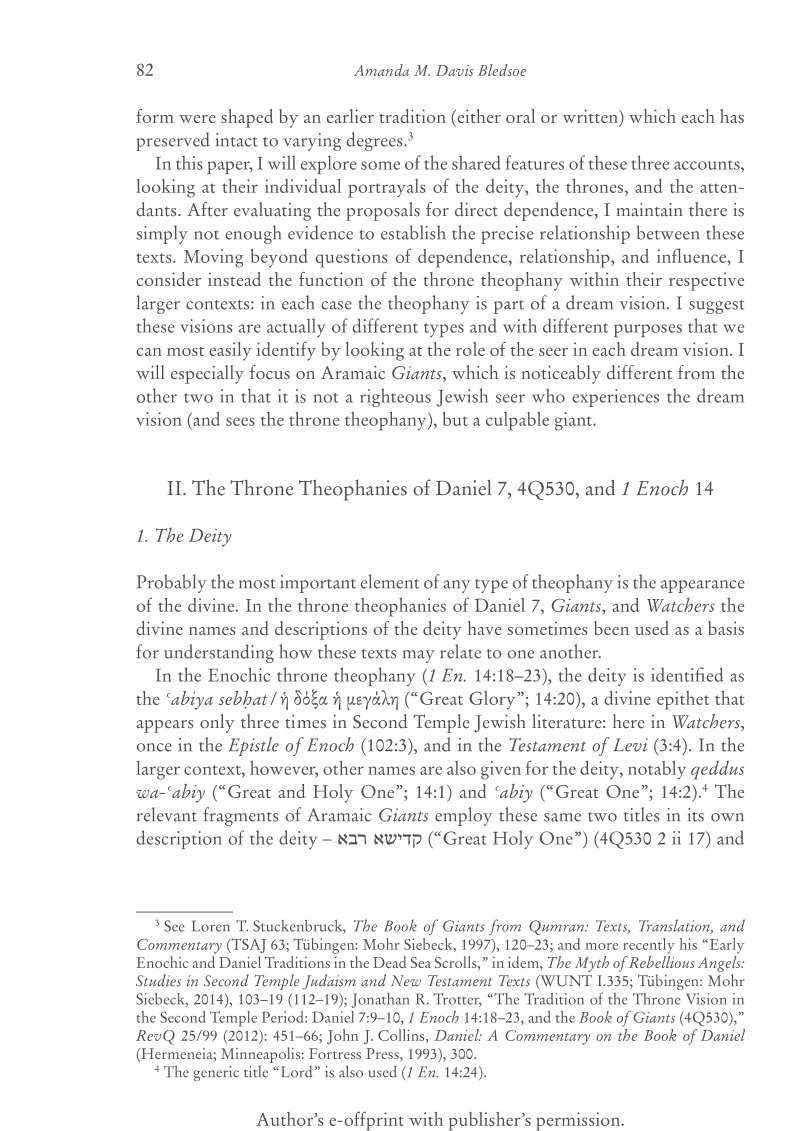Amanda M. Davis Bledsoe identifies the "Ancient of Days" with "the Most High" in Daniel 7; discusses reception of the "Ancient of Days" in 1 Enoch that identifies this figure with God.
- Type
- Book
- Source
- Amanda M. Davis Bledsoe Non-LDS
- Hearsay
- DirectSecondary
- Reference
Amanda M. Davis Bledsoe, "Throne Theophanies, Dream Visions, and Righteous(?) Seers: Daniel, the Book of Giants, and 1 Enoch Reconsidered," in Ancient Tales of Giants from Qumran and Turfan: Contexts, Traditions and Influences, ed. Matthew Goff, Loren T. Stuckenbruck, and Enrico Morano (Tübingen: Mohr Siebeck, 2016), 83-84
- Scribe/Publisher
- Mohr Siebeck
- People
- Amanda M. Davis Bledsoe
- Audience
- Reading Public
- Transcription
In the Danielic throne theophany (7:9–10) only a single title appears, עתיק יומין” ,Ancient of Days” (v. 9), though elsewhere in the chapter the deity is referred to as either “Ancient of Days” (vv. 13, 22) or עליא” ,Most High” (v. 25). While “Most High” occurs commonly throughout Daniel as well as elsewhere in the Hebrew Bible and numerous texts from the Dead Sea Scrolls, the title “Ancient of Days” is known in all of Second Temple Jewish literature only from this chapter of Daniel. Nevertheless, some commentators have claimed the deific titles of Daniel 7 and 1 Enoch 14 are related to one another. In his study of the relation of these throne visions, Helge Kvanvig reconstructs the Great Glory of 1 En. 14:20 as רבתא רבותא in Aramaic, which he translates as “the Great (old) Majesty.” Citing a segment of 11QtgJob where God’s greatness is paralleled with his multitude of days, Kvanvig suggests that the Danielic Ancient of Days could then be understood as a derivative of רבתא רבותא” ,considering that the time aspect of רב is stressed.” Provided that Kvanvig’s reconstruction is correct (though this is far from certain), the example from 11QtgJob in no way indicates the prevalence of this understanding of רב ,and it is still more difficult to imagine the suggested correspondence (and dependence!) between “the Great (old) Majesty” of 1 Enoch 14 and “the Ancient of Days” in Daniel 7.
Besides the naming of the deity in these accounts, the visions of both Watchers and Daniel also include a brief description of the deity’s physical appearance – an element lacking in Giants. In Daniel 7, the Ancient of Days’ clothing is said to be white like snow, and the hair of his head is compared to pure wool (v. 9). Though quite longer, the description of the deity in Watchers presents several points of comparison. It too speaks of the Great Glory’s clothing – it is “like the appearance of the sun and whiter than much snow” (1 En. 14:20)– and makes mention of the deity’s face, which neither angel nor human is able to look upon on account of its splendor and glory (v. 21).
In a recent article, Ryan Stokes analyzes the depictions of the deity in these two accounts. He notes that (1) their descriptions follow the same order: the deity sits, his clothing is described, then his hair or face is discussed; and (2) their description of God’s clothing as white, specifically in comparison with snow, is not found in other texts of this period. Together he takes these two elements to indicate the probable dependence of one text on the other. Stokes then identifies the depiction of the “superbly anthropomorphic gray-haired old man” in Daniel as being rooted in ancient Canaanite traditions, and argues that this portrayal of the deity is necessarily older than that of Watchers, which describes the “glorious God, upon whom neither humans nor angels can cast their gaze.” He further reasons that the author of Watchers would have had greater reason “to alter Daniel’s vision according to the biblical tradition that one cannot see God” rather than the other way around and, thus, concludes that “the Enochic tradition reflects a development of that found in Dan 7.”
- Citations in Mormonr Qnas
The B. H. Roberts Foundation is not owned by, operated by, or affiliated with the Church of Jesus Christ of Latter-day Saints.

